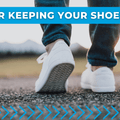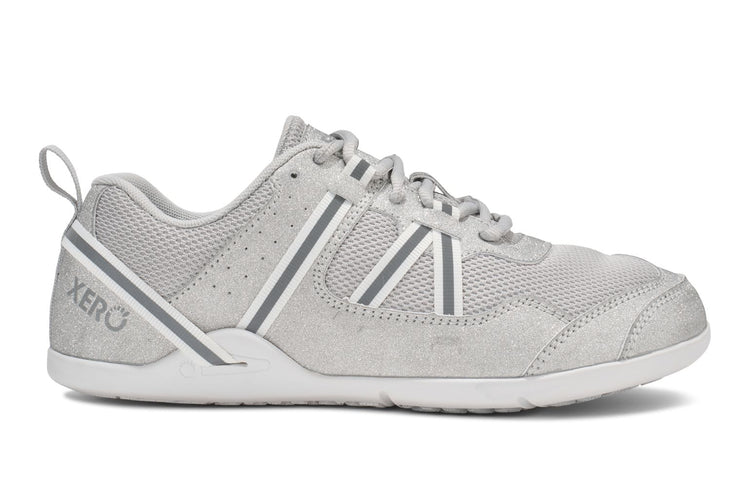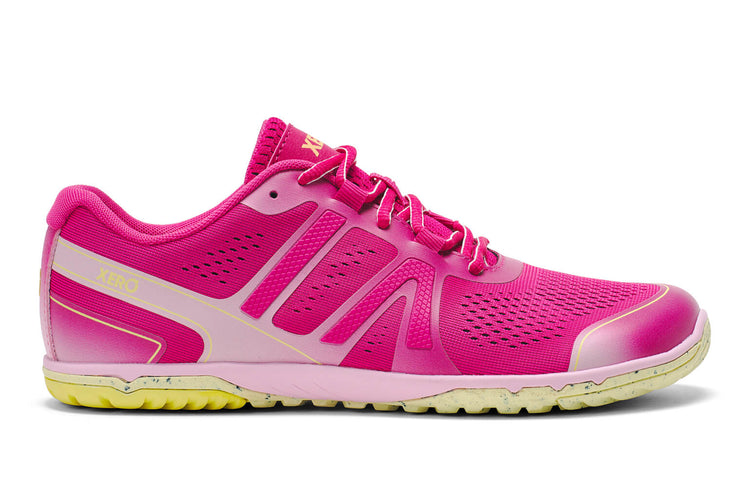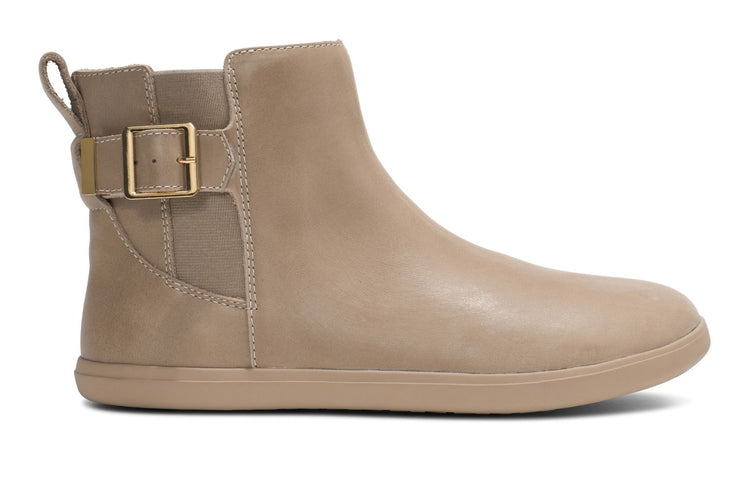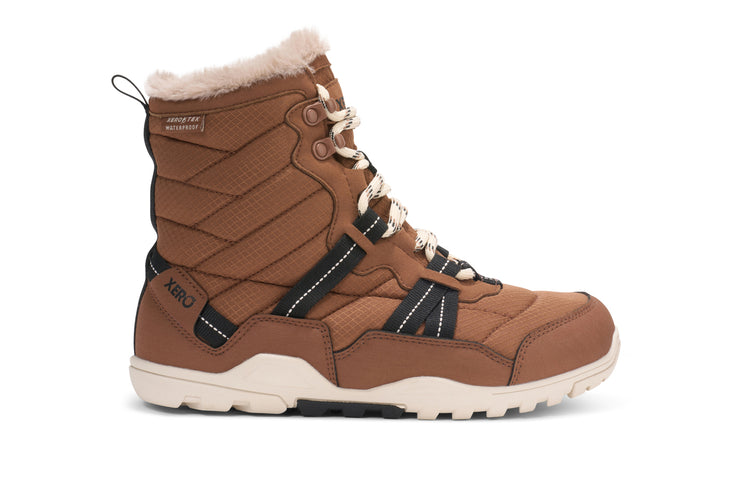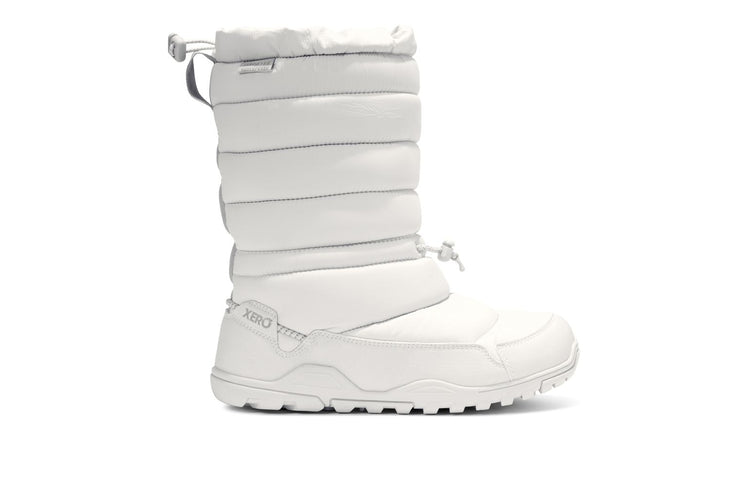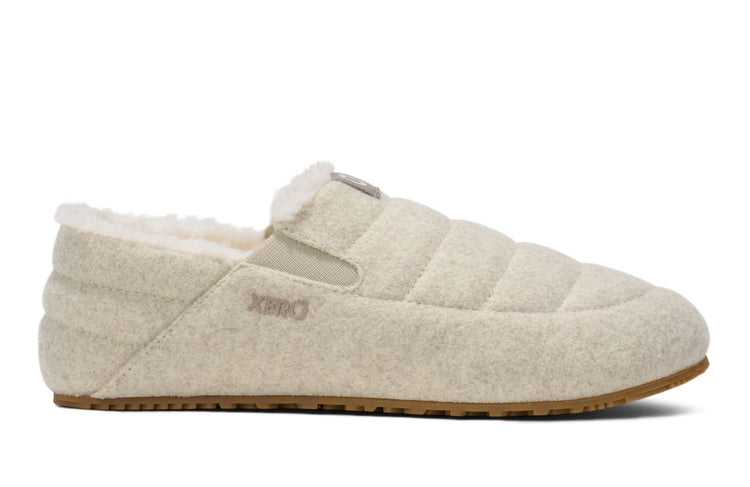“The Dream Shoe”: A Partnership with Xero Shoes & Born to Run 2 Authors
latest News
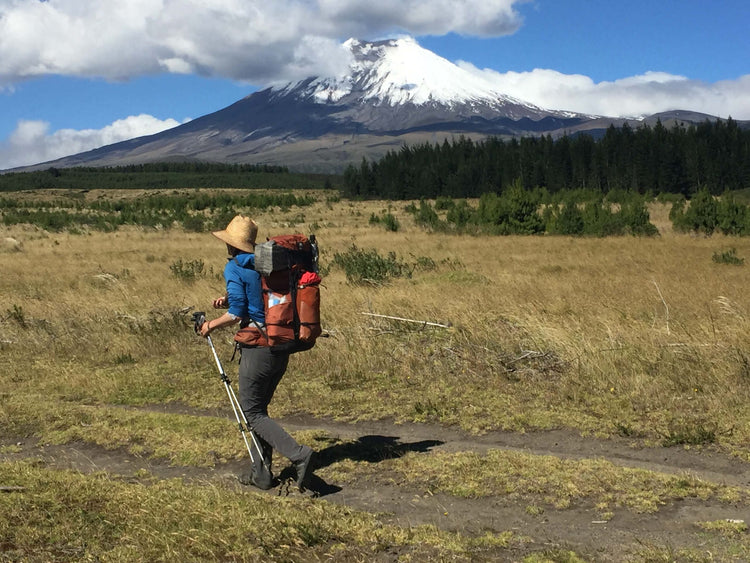
Foot Care for Endurance Athletes
“And forget not that the earth delights to feel your bare feet.” Khalil GibranOf the 206 bones in your body, 52 are in your feet. Each and every one contributes to getting you to where you are going and is a potential major hindrance if not cared for. As a long distance, long term athlete, I spend a lot of time on my feet. Over the last 7 years I have hiked 12,000 miles, paddled 1,500 miles, and bikepacked 4,000 miles. With 3,500 miles left to complete a non-motorized traverse of the Americas, physical maintenance, and specifically foot care, is crucial.One of the important lessons I’ve learned has been moderation. It sounds silly putting those two thoughts into the same sentence but it is a fundamental truth to how I’ve been able to keep going for so long. Maintaining a pace and stride which works for me, resting when my body needs it, and giving it the resources it needs to stay healthy and moving are all examples of moderation and care which I began learning when I started thru-hiking over a decade ago. And which I continue to learn and relearn when my body makes her demands known or insists in the form of months of illness, repeated bouts of overuse injuries, or other physical break down.Interestingly, these sorts of issues don’t usually spring upon you all at once. There are signs, symptoms. That tweak in your lower back. Is that a one time thing or is that the beginnings of chronic pain? Every endurance athlete knows this fear and the fact is, you never can know which it is going to be. What you can do is incorporate a steady practice of care and strength building to give your body its best chance. Similarly, there are dozens of small things you can do to prevent going down that road, or to aid in recovery as you regain strength and stamina. These are a few of those small practices which can make a big differenceDry Your FeetI spent the first 3 years of my backpacking career battling with trench foot. I came to think it was simply part of the experience. I tried doubling up on socks, traded my way up into Gortex boots and the issue only worsened. When wearing shoes and socks, your feet are experiencing a very different climate than the rest of your body. Usually it is a warm, damp environment, just the sort of place fungus like to grow. I was super glueing deep cracks in my heel shut. Until finally one day I swung in the opposite direction and wore lighter shoes and began airing my feet out more often. I quit sleeping in socks and the issue subsided.If you go barefoot or wear open sandals, your feet will be able to dry naturally. Still, if you are on a multi-day trip, rinse or wipe your feet off at the end of the day, paying special attention to the areas between your toes. Not only will this keep your quilt or sleeping bag cleaner, but it will also keep your foot skin healthier.When you are in a closed shoes sort of environment giving your feet time to air out whenever possible. Whether that is under your desk at work, on a lunch break along the trail, or the drive home from the trailhead, keeping your feet clean and exposed to the open air contributes significantly to your foot health. Mix it UpCross-training caught on in the endurance sport world over the past 20 years. All our muscle groups were made to work together so having one set particularly overdeveloped while others languish, doesn’t serve the sustained health of our physical systems in the long run. The same goes for our feet.While thru-hiking the CDT this past summer, I was retraining my feet after several months spent exclusively in my Xero sandals on sandy beaches and in a kayak. Due to constant high mile days, the weight on my back, and the terrain, I opted to hike in trail runners with more padding and zero drop and quickly began to have arch pain. Thus I began alternating between my sandals and trail runners throughout the day.Once the frosty mornings were past and when I took a breakfast break and aired out my feet, I would switch into my sandals for a few hours until lunch. At big river crossings, on smooth trail, and around camp, I was in my sandals. On thorny bushwhacks, across lava rock, and other rough environments, or at the end of the day when I was tired and not able to be as careful with my step, I would switch back into my trail runners. This switching back and forth made me very aware of my gait which is helpful because a hyper-extended gait is a leading cause of shin splints. While the cushion of the trail runners invited this sort of step, my Xeros reminded me not to fall into that.Thus, if like me, you aren’t ready to spend 100% of your time barefoot, there are still many ways and a lot of space for barefoot practices to improve your awareness of how you move, and your experience of both your body and the outdoors. Thank Your FeetNow, here I may get a bit hoakey for some folks, and I don’t mind if you skip on to the end, but at the end of a long and challenging day, I like to thank my feet. I leave my shoes at the vestibule, peel off my socks, and either soak my feet in a nearby stream or give them a good wipe down with a baby wipe. Then, sitting in the butterfly position or lying on my back in a modified happy baby pose, I wrap my hands around my feet and begin to stretch. Beginning just above my ankle bone I rub small circles and check in with all those tiny bones. With the texture of my skin. With the cracks in my skin. I thank them for the miles they have put in. Marvel at the ground they have covered and conditions they have weathered. Doing this I work my way all the way down the tops of my feet and then begin again at the ankles and cup my heel. In thru-hiking, that part of the foot takes a lot of heavy strikes and a lot of modern footwear encourages this, so they get an extra thank you for taking that extra whooping. Focusing on the soles of my feet and paying particular attention to both arches, I make my way to the toes. Stretching each toe individually and then tugging outward from the tip, pulling them long and a good final stretch before crawling into my sleeping bag and asking my body to do it all over again tomorrow.Endurance athletes ask a lot of our bodies but every thru-hike, ultra, or even just a junt around the block starts with one small step. The same measured moderation and care applies to foot care. Taking a few minutes out of your day or tacking a few extra on to your training routine may be hard to convince yourself of when you are trying to make miles or balance a busy lifestyle. Whether it is washing and airing out your feet, switching out shoes, or staying awake a few minutes longer in your tent to stretch your soles, small steps can make the biggest difference in the long run. After all, your feet are carrying the most weight on your body, giving them a few minutes of dedicated care is the least you can do.–Adventurer Bethany Hughes The content of this post does not constitute and is not intended to be a substitute for professional medical advice, diagnosis or treatment. Always seek the advice of a physician or other qualified health provider with any questions or concerns you may have about your health or a medical condition.

Can you get Energy Return from your shoe's cushioning?
I wish more people understood physics better.Sure, I say this in part because I got interested in physics at an early age. When I was 14, I was tutoring people 3-5x my age in antenna design, electronics, and other physics-related topics (I was an Extra class ham radio operator).But the other reason is that knowing physics makes you immune to certain types of marketing spin, which can save you countless hours of time (not having to personally test something that's patently false), and money (not buying products marketed with misleading bastardizations of principles of physics).It also makes you an unpopular party guest, since people don't like having their mythology bubbles burst, and when you overhear someone spouting incorrect explanations of reality, it's impossible to walk away without tossing in a corrective comment.At least I can't.What does that mean when it comes to finding comfortable shoes, sneakers, sandals, and any other type of footwear?Two words:ENERGY RETURN FROM RUNNING SHOES? Running shoe companies in particular tout the "energy return" of their foam or other types of cushioning.The more energy return, the better.Makes sense, right?Well, let's just say that if I heard you waxing eloquently about the energy return in your new, super expensive, high-tech, cushioned shoes while you sip a beverage from a Solo cup, I'd force my way into the conversation and say:"There is no such thing as 'energy return.' "Even if I didn't have my own Solo cup's worth of liquid (and it would probably be water; I'm not much of a drinker), I'd then blurt out:"There are only different levels of ENERGY SUCK."It's just physics.No foam or cushioning or springs or shock absorbers or carbon plates or anything else that's ever been added to any part of a shoe has ever RETURNED more energy than you put into it when you land on it.Therefore, all of those components SUCK energy from you.Think about a trampoline. Sure you can bounce really high... but only until your leg muscles get tired. The trampoline bed optimizes the combination of gravity and your musculature (but only to a point, since you don't keep bouncing higher and higher forever).Same thing with foam in your shoes.The foam sucks.And, worse, it sucks more and more with time because it begins to break down the moment you start using it.My friend, Dr. Geoffrey Grey from Heeluxe (a footwear research firm) just wrote a great post about this: Why Energy Return is a MythHe addresses the new Nike Vaporfly 4% and the Nike Next % as well as the VKTRY insoles, but his points apply to all shoes Here are the highlights: Key Point 1: All foams lose energy.We already touched on this. And, again, it's not just foam.All cushioning does the same thing. Key Point 2: Carbon Fiber isn’t typically used as an energy return material.The carbon fiber in the Nike shoes and the VKTRY insoles is held out as part of the energy return equation.Carbon fiber is stiff.If you think about it, having a layer of carbon fiber is just adding a non-compliant surface into the shoe... like a road or a track or a sidewalk.There are some who claim that the carbon fiber plate in the Nike shoes "act as a lever" and that's what creates energy return.Again, sounds good unless you understand physics.For a lever to function, it needs a fulcrum.There's nowhere in the shoe that's a point on which the carbon plate rests or pivots.Even more, check out where the runners in Eliud Kipchoge's sub-2 hour marathon land on their foot (and therefore in the shoe):Notice where they're landing?Midfoot and forefoot.There's no fulcrum under the midfoot. So, no lever. Just something solid, again, like the ground.Next... Key Point 3: Shoes with higher energy return on mechanical “ball drop” tests won’t work for everyone.The "ball drop test" is how most shoe companies demonstrate their "energy return."They literally drop something like a 2 pound metal ball onto the sole of the shoe, or the cushioning material, and see how far it bounces back toward the original height.Physics -- NEVER higher than where it started.Reality -- YOU ARE NOT A SOLID 2 POUND METAL BALL! (I'm assuming)The ball is only accelerating toward the sole based on gravity (accelerating a 9.8 m/s squared). You are not falling from that same height and the force that you hit the ground is not the same as a 2 pound steel ball.If you weigh 150 pounds, you could hit the ground with 500-600 pounds of force, or more! And your muscles, ligaments and tendons allow your joints to BEND, unlike the metal ball which doesn't compress (okay, technically it does by a TINY amount).More Physics -- foam breaks down from the moment you start using it, so the ball test results will change over time.In fact, the reason most shoe companies tell you to replace their shoes every 3-500 miles is that this is when they think the foam has degraded to the point of being useless (and, often, they make sure the rubber outsole wears out at about the same time).SHOE SECRET -- most foam is barely better at 300 miles than 500... and often it's just as bad at 200 miles! Key Point 4: Foams with higher energy return feel good to some people.Feeling good is a wonderful thing.But that doesn't mean it's DOING something good for you.Let me ask you a question:If you were going to do pushups, would you rather do them on the floor or on a memory foam mattress?I'm guessing you said "Floor" and the reason is that you know a foam mattress is squishy and would make you unbalanced, while the floor gives you something solid and stable as a base.This is basic Newtonian Physics (the 3rd law) -- For every action, there is an equal and opposite reaction.If the opposite reaction is squishy, it messes up your initial action.The mattress FEELS good, but isn't good for natural movement.Same thing with foam in a shoe.Wrapping it up...Needless to say, we think of Xero Shoes as "physics friendly."Our barefoot shoes don't use unnecessary amounts of foam. We don't use marketing spin to take something bad (foam sucks energy) and re-label it with something that sounds positive, like "energy return."We believe that you're smarter than that.Even if you don't know a lot about physics ;-) What do you think? Leave a comment, below.
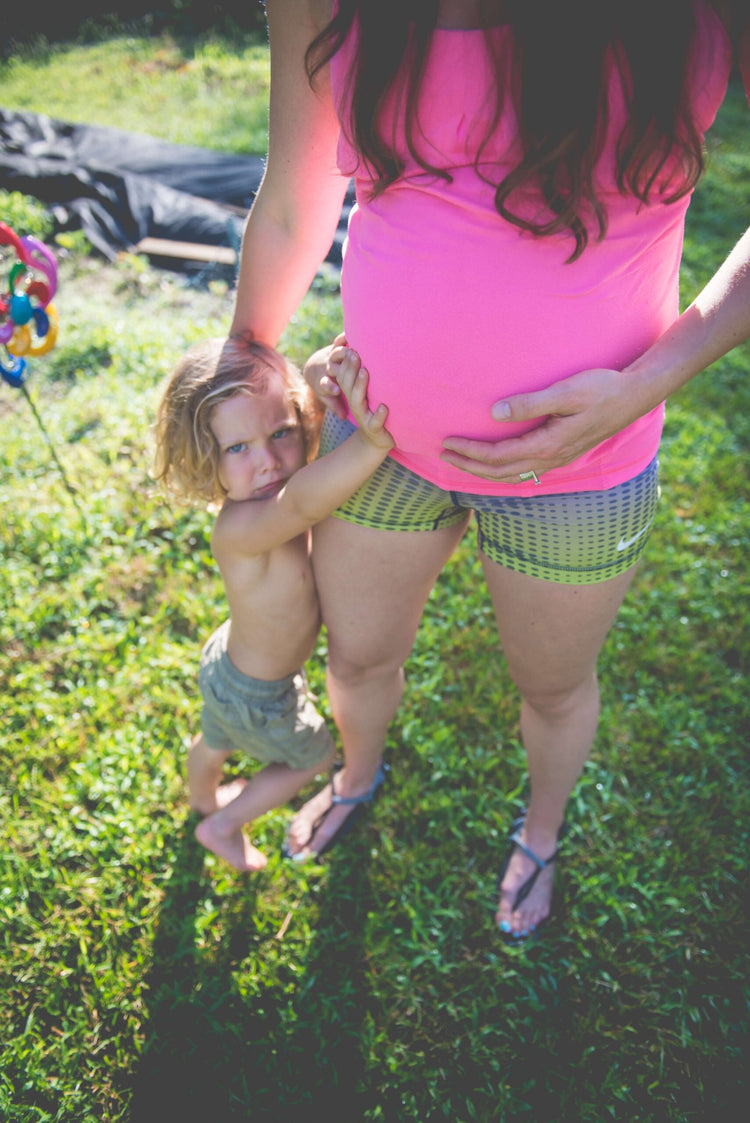
Why it Makes Sense to Switch Your Shoes During Pregnancy
From a big picture standpoint, pregnancy is a time of growth and change. The anatomy of a mother’s body is rapidly adapting to the projected growth of the fetus (things like a widening pelvis and ribcage, changes in spinal curvatures, stretching of abdominal tissues, and shifts in the center of gravity). A lot of the changes happening are credited to relaxin, a hormone that is found in numerous tissues and systems throughout the body, but increases during pregnancy and breastfeeding and acts to relax tissues.One of the changes that many women experience during pregnancy is a change in shoe size. Rather than lamenting this perceived inconvenience, I think it’s a perfect opportunity to take advantage of the body’s changing physiology.Feet that have been convinced to look like shoes rather than feet often have an uphill battle in regaining their natural shape, flexibility, and strength. But when relaxin is present, the body is more amenable to change. We can take advantage of this and invite our feet along for the ride.There are a few reasons why pregnancy is the best time to make the change to more neutral and natural footwear options. Here are three: As I mentioned earlier, there’s relaxin; this hormone is helping the body prepare for the baby to grow as well as exit the body, which means it’s making changes. Adding in some simple foot mobilization can feel great and also may help accelerate these changes. The shift forward in the center of gravity makes being pregnant similar to wearing high heels when non-pregnant. Doubling down on this shift forward causes most women to avoid wearing heels when pregnant. But whether they’re stilettos or traditional running shoes, shifting the center of gravity even further forward than it already is during pregnancy generally feels uncomfortable in the calves, quads, and low back. There’s no better time to be barefoot. Pregnancy calls us to really be IN our ever-changing bodies. Taking some time to pause, connect to the ground, and just BE can be incredibly beneficial. From a literal standpoint: the more comfortable you are with your feet on the ground, the easier it is to stay grounded. A few ideas to get started if you’re making footwear changes while pregnant: Go slow. There are a lot of changes taking place in your body; don’t overwhelm it. Start out just being barefoot in your house; once that’s completely comfortable, add in walking outside barefoot. When you change footwear, don’t wear your new shoes all day. Start with a few hours, and gradually build up the amount of time you spend in your new kicks. Speaking of new shoes: Your foot may continue to change sizes. As pregnancy progresses, your feet may increase in size; this might revert postpartum, but it might not. From an economical standpoint, it probably makes sense to get some multi-purpose shoes (ones you can wear to work, but also workout or go hiking in) rather than swapping out every single pair of shoes you own only to find that the size change was temporary! Wiggling your toes is a simple way to bring awareness to your feet and get them moving in a way that doesn’t typically happen while shod. Barefoot shoes allow for ample space for your toes. Try to move the toes individually and slowly for more of a challenge. Relaxin stays present in the body postpartum, so in the first few weeks postpartum while you are allowing your body to regulate to its new normal, you can gently work on foot and ankle mobilizations. A time of growth and change can be scary and overwhelming. But if we take small steps (literally), this amazing time can actually give us a much-needed boost in helping our body function at its best! Looking for shoes that will provide comfort during your pregnancy? Explore our entire collection of barefoot shoes for women.Lindsay Mumma, DC@lindsaymummaPhotos by Amanda Ditzel, Raleigh Birth PhotographyThe content of this post does not constitute and is not intended to be a substitute for professional medical advice, diagnosis or treatment. Always seek the advice of a physician or other qualified health provider with any questions or concerns you may have about your health or a medical condition.
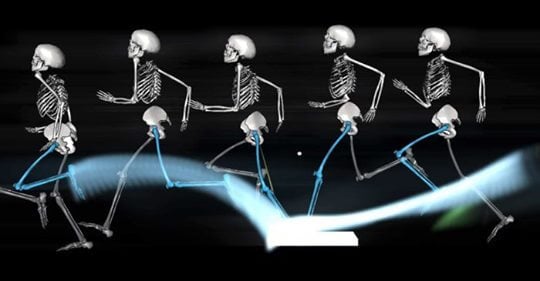
Are you running WRONG?
What's the difference between "good running" and "bad running"?Those of us who promote natural movement and barefoot running have some thoughts about that.Typically, we talk about: Landing with your foot "under your body" (don't reach out in front of your body with your foot -- "overstriding") Increase your cadence a bit (there's no magic number, like 180 steps per minute, but increasing your foot speed without increasing your running speed makes overstriding more difficult) Land on your forefoot or midfoot (it's hard NOT to land that way if you don't overstride, and don't point your toes to make this happen. BTW, some research suggests forefoot is better because it lets you use the "spring" in your foot's arch) Keep your core engaged (you want to be a "tight spring") But what does SCIENCE say?Well, take a look at this super-cool presentation by David Mark, showing some running analysis by biomechanist Dr. Aaron Beachhttps://www.abc.net.au/news/2019-12-11/why-everything-you-thought-about-running-is-wrong/11775598They use some great visualizations to compare Olympian Jenny Blundell to recreational runner, Ruby Cornish.The only thing different in Beach's analysis and recommendations from what I show above, is that he doesn't suggest trying forefoot landings. But my bet is that if Jenny was a forefoot landing runner he'd comment on the value of doing so.One other subtle thing is that he recommends that Ruby have more hip extension (or what some would call "backside mechanics"). This isn't something to work on, but simply the effect of having a stride where your foot lands under -- or close to -- your center of mass, with the correct cadence.It why we say that good runners "run out of the back."I think you'll love the visualizations. Let me know what you think.
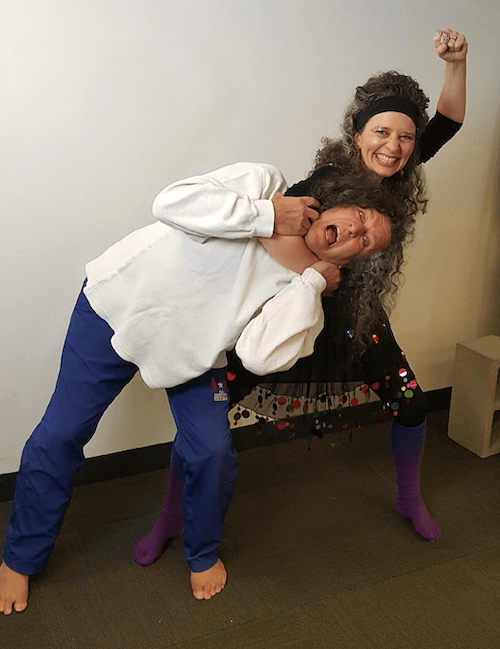
Happy Xero-ween!
Halloween is a favorite day here at the Xero Shoes office. Lena Phoenix -- Xero Shoes co-founder, CFO, and G.L.O.W. (Gorgeous Lady of Wrestling!) Halloween? Or just another typical Thursday at the Xero Shoes office? But, then again, we also dress up for "Onesie Wednesday" and "Non-casual Friday" (which is more open-ended than Formal Friday). Of course, some people go above and beyond and dress AS XERO SHOES! Whether you trick-or-treated or just gave out candy, if you did it Xero Shoes, we want to see your pics and how you Live Life Feet First!
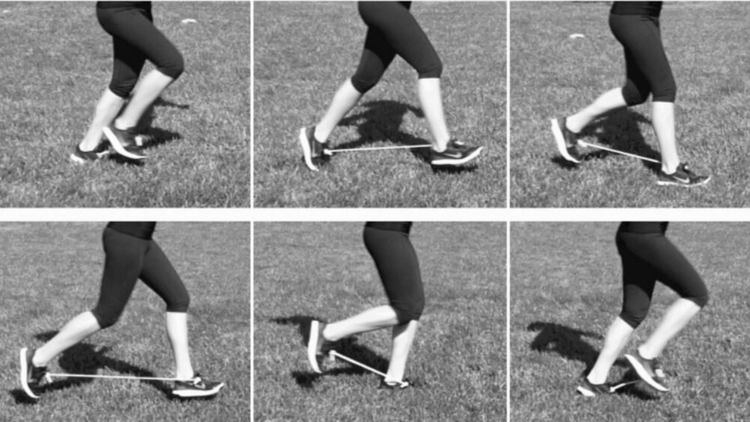
A Rubber Band is the Secret to Better Running?
Could a new form of foot binding be the secret to better running?I don't mean wrapping up your feet in the infamous style of ancient China, but something developed by some mechanical engineers at the University of California, Santa Barbara.In short, they attached some rubber tubing between runners shoes and found that they ran more efficiently.Every stride, you slow your body down and speed it back up again," losing energy that could otherwise be conserved or put into running faster, said Elliot Hawkes, who was a postdoctoral fellow at Stanford when the research was conducted. "90 percent of the energy you put into running is wasted, in a sense.The solution to this, according to the researchers?Tie the legs together with a rubber band. Adding that band between a runner's legs could help slow both legs when they are far apart, then give them a little kick as they came back together--saving energy at both ends.While they didn't publish images of runners who weren't using the rubber tubing, here's what they showed for runners who used what they call an "exotendon":What was the effect?An improvement in VO2 Max (what many people think of as running efficiency) by an average of 6.4%Sounds amazing right?But before you go out and buy an exotendon, let's take a look at what's REALLY going on here.Can you see what the rubber band does?Start by looking at the middle image in the top row, above.You can see that the runner is about to land on their heel, with the foot relatively far in front of their body. This is a typical "overstriding and heel strike" pattern.When you run like this, every time your foot hits the ground that far in front of you, you're basically putting on the brakes. And when you land on your heel like that, research shows that you're sending force into your joints rather than using your muscles, ligaments and tendons naturally -- as built-in springs and shock absorbers.Now look at the far right image in the top row.The runners foot doesn't actually land as far in front, or as much on the heel, as it would if it weren't being pulled back by the rubber band.You can see in the bottom row that the runners form has changed and isn't overstriding as much, and is landing in a more mid-foot pattern.Hopefully, I just saved you some money or time. No need to buy or build your own exotendon.What the exotendon is doing is giving the runner a cue to run in the way that most people do when they get out of padded, elevated-heel, motion-controlled shoes!Want the same effect?Simply take the time to adapt to "natural running," by landing with your foot closer to your center of gravity instead of far out in front of you, and land, ideally, on your forefoot (no need to STAY on your forefoot only, let your foot do what's natural and use the springs built into it... your heel can drop to the ground if it feels right to do so).BTW, while many barefoot runners say that either a midfoot or forefoot landing is what you want to do, research from Harvard's Irene Davis shows that impact forces are lower with a forefoot landing than a midfoot one. So if you're a mid-footer now, you may want to experiment with "moving up" to the forefoot.Another thing that the rubber band did for runners: their cadence went up. That is, the number of times their feet hit the ground in a minute increased (without running faster). Obviously, you can do that on your own, too.The researchers say that the exotendon only works when running on flat surfaces. Needless to say, you can use natural movement anywhere, any time, under all conditions.To be fair, I'm actually NOT badmouthing the exotendon. In fact, it could be a great training aid to help people feel what a better movement pattern is like and make the switch.But it's important to know what's really going on, what the real purpose of the device is. That could actually make it MORE effective, and wean you from it more quickly.Frankly, I'm in favor of whatever it takes to help you Live Life Feet First.Keep this one last thing in mind though -- if you thought you go weird looks when you tried running barefoot, or even in Xero Shoes, just wait until you hear the comments when you strap a rubber band to your feet and hit the roads!The content of this post does not constitute and is not intended to be a substitute for professional medical advice, diagnosis or treatment. Always seek the advice of a physician or other qualified health provider with any questions or concerns you may have about your health or a medical condition.
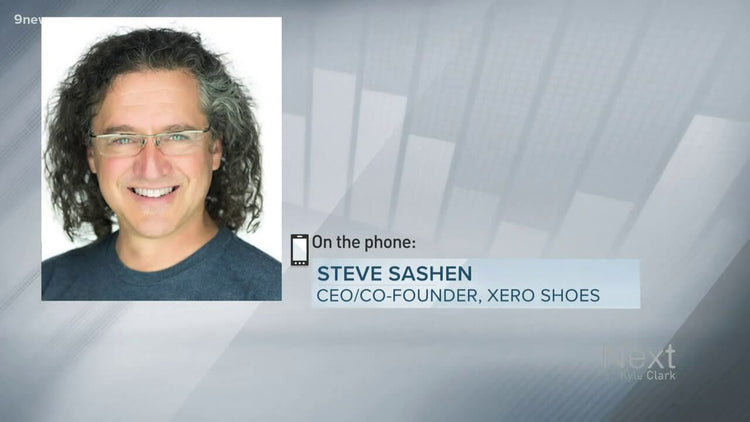
Our Denver boot is the opposite of a Denver Boot!
If you haven't already figured it out...We TOTALLY missed the connection between our lightweight, cold weather-friendly Denver boot and, well, a "Denver Boot" -- the thing they stick on your wheel when you're a parking scofflaw!The "actual" Denver Boot immobilizes you, while OUR Denver boot let's you move light and free thanks to its natural movement design:Your feet are made to bend, flex, move and FEEL the world.One-quarter of the bones and joints in your ENTIRE body are in your feet and ankles; you have more nerve endings in your soles than anywhere but your finger tips and lips.True comfort and performance come from using your feet naturally.That's what Xero Shoes, including the Denver, let you do. Natural Fit -- wide toe boxes let your toes spread and relax. A non-elevated (zero-drop) heel for proper posture. Natural Motion -- super flexible to let your feet bend and move naturally. Low-to-the-ground for balance and agility. Natural Feel -- the patented FeelTrue® soles give you just-right protection while still giving the ground feedback your brain needs for efficient, natural movement. Plus their super lightweight, and the soles are backed with a 5,000 mile sole warranty.Good thing we didn't name our new shoe the Horse! ;-)
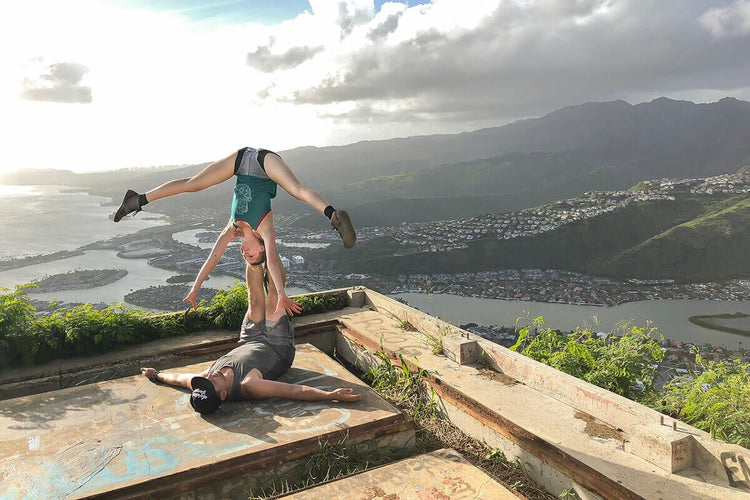
Hiking on a 49% Grade: Koko Head Crater Trail
If you’re ever on the Hawaiian island of Oahu, take time away from the beach to hike Oahu’s many trails. Each are beautifully unique, providing you access into the mountains or a path to breathtaking views. One of the most unique hikes you’ll ever experience is the Koko Head Crater Trail. Created by the military during World War II, this trail is a perfectly-straight line up the face of an ancient volcanic crater. The higher you go, the steeper the trail becomes. The trail is actually a former tram railway, where you’ll step on 1,050 railroad ties. Due to the extreme slope, each railroad tie is essentially a stair, providing a relatively safe, but exhausting climb to the summit. As the slope increases, each stair is substantially higher than a normal, seven-inch stair that you’re used to. Plan on 12-18” of gain with each step as you approach the top. Our Strava recorded a 49% grade for the entire top section of the rail trail. Forty-nine percent. You’ll definitely want to feel each railroad tie, safely below your foot, before you transfer your weight and step up. We loved the stability and light-weight simplicity of our DayLite Hikers, protecting our feet from the scorching-hot surface of the old railroad ties, while providing the flexibility needed for our feet to feel their way to the top of the climb. The ankle support and protection of the DayLite Hiker was also a huge advantage, as we asked our legs to do things they normally don’t do. There is one short section where the railroad ties are elevated. Don’t look down as you cross 50’ above the ground, stepping from one railroad tie to the next! This section of the trail is one of the flatter parts, and it will be over before you know it.Facing south with some head-tall vegetation, the trail is very exposed. We recommend an early-morning start to beat the heat and beat the crowds. Take more water along than you’d normally hike with. We’d definitely recommend a pack-mounted hydration system, since you’ll almost-certainly be scrambling on all fours on certain parts of your trek. Take several breaks going up—especially as you near the top. It may take you 20-45 minutes but it’s worth every step. Once you arrive at the top of the trail, explore the concrete remains of the World War II mountain-top military installation. You won’t be at the summit, but you can easily get there by climbing another 50-75 feet of elevation as you walk along the concrete structures and the connecting dirt paths. Known as a pillbox, these WWII-era, concrete structures are located on strategic viewpoints throughout the island, and are the destination for several dozen trails.The view at the top is spectacular, with 360-degree views of the surrounding area. Most impressive is the view of the trail itself, as you see a straight line descending below your feet back to the parking lot. In 0.7 miles of climbing, you will gain nearly 1,100 feet of elevation, and the return walk is as simple as putting one foot in front of the other.The Koko Head Crater Trail is easy to access, located near Hanauma Bay and the city of Hawaii Kai. Parking and the trail are free, but are quickly growing in popularity. Get an early start, stay hydrated, and be prepared for a unique experience that your legs will never forget.@WildAcroDuo Chris & RoxyThe content of this post does not constitute and is not intended to be a substitute for professional medical advice, diagnosis or treatment. Always seek the advice of a physician or other qualified health provider with any questions or concerns you may have about your health or a medical condition.
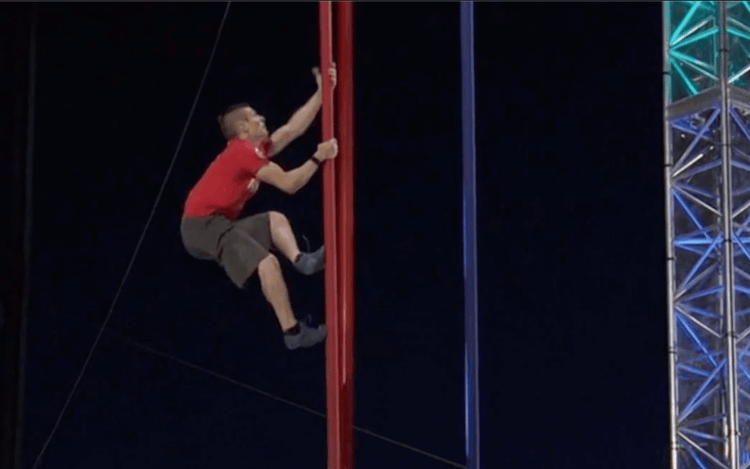
Dave Cavanagh + Xero Shoes Prio = American Ninja Warrior!
BIG CONGRATS to Dave CavanaghDave is a multiple-time "walk on" to American Ninja Warrior. He was, finally, invited to compete in the recent try-outs in Baltimore and... well... check out how he did.And check out the shoes he's wearing!Yup, those are our best-selling running/fitness shoe, the Prio. Dave is heading to Las Vegas for the finals and we're all rooting for him!
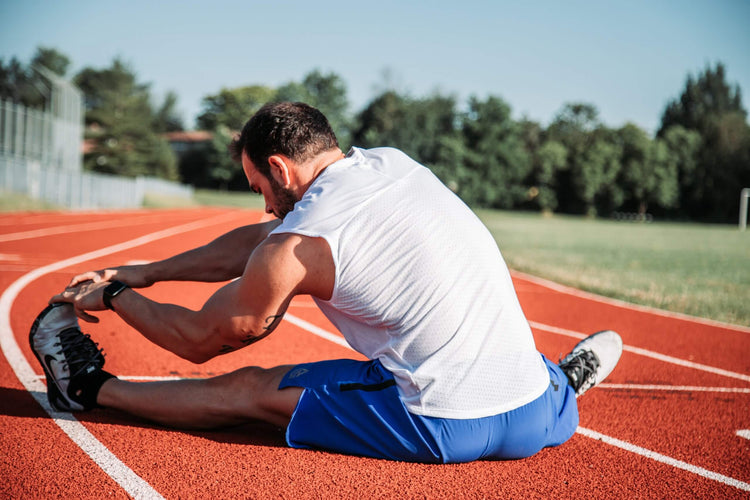
The Hidden Hamstring: Release Low Back Pain - Xero Shoes
By Matt Giordano, @theyogimatt Updated 7/26/22 The Lower Back Do you suffer from tight hamstrings?Many runners, active adventurists, and even those who sit at a desk all day experience tremendous hamstring tightness. (“Hamstring” is the term usually used for the muscle group that runs along the back of your thighs.) As a result, the pelvis might get pulled downward in a tucked (posterior tilt) position causing the low back to be chronically rounded (flexed).For most people, constantly tight hamstring muscles will result in lower back tension, discomfort or issues with your intervertebral discs – which exist between each of your vertebrae in your spine, providing cushioning for shock absorption. Preserving the natural curvature of the lower back and avoiding back pain (or nerve pain) can prove to be challenging if the hamstrings hold tension from overuse or underuse.What most people don’t understand about the body is that it is constantly trying to correct itself. When the hamstring muscles are tight and pulling the pelvis into a posterior tilt, the lower back will hold tension because those muscles, in turn, are trying to pull the pelvis back toward neutral in order to bring the proper curvature back in the lumbar spine.So most people feel the tension in the lower back and start stretching those muscles. Unfortunately, this perpetuates the issue and can even exacerbate pain. What might be the better solution is to strengthen those muscles and stretch the muscles that are the root of the tension – the hamstrings.The challenge is finding the right hamstring stretch to properly loosen the hamstrings. So what is the best approach to hamstring stretching?The “Hidden Hamstring”Something I have noticed in most athletes is that when they stretch the hamstring muscles they do all the right stretches – like a standing hamstring stretch where they bend forward over one leg, or a chair hamstring stretch where they bring their leg up on a bench, etc.However, it is rare that I would see them stretching the inner thighs as well. As a result, they are missing what is often referred to as the fourth hamstring or what I call the Hidden Hamstring: The adductor magnus.The adductor magnus squeezes the legs toward each other like the other adductors, but uniquely it also extends the thigh back behind the hip (the back leg when running or walking).Now often when we do a hamstring stretch the hamstring muscle can be tight enough that it doesn’t allow us to get into the stretch of the adductor magnus. In other words, hamstring muscle tightness holds us back from getting to the necessary depth.Rather than straining and overstretching the hamstrings to target the adductor magnus we can simply add a slightly different stretch, one that also targets the adductors (inner thighs).Let me explain how it’s done.Best Hamstring Stretches: The Magic Pose There are a couple of amazing postures in yoga that stretch the adductors and the hamstrings at the same time. One of the best ones for hamstring stretches is the “Triangle Pose.”This pose is one of the most iconic yoga postures and there’s a great reason why! It not only stretches the hamstrings, but also the inner thighs and sides of the torso. With slight variations of the shape, you can change the intensity of stretch in each area and target your tight areas, and back off your flexible ones.If you are new to the Triangle Pose or generally have tighter hamstrings and adductors I highly recommend having a yoga block, books, or a chair to put your bottom hand on so that you don’t risk straining any of the muscle groups in this posture. A slight stretch is all you need.A very similar pose is called Side Angle, and this is triangle pose but with one knee bent. With the knee bent you will reduce tension in the hamstrings and actually be able to stretch the adductor magnus a bit more easily, so I recommend starting here and then moving to Triangle Pose. If your hamstring stretches are too aggressive you risk injuring your muscles.Now for the practical part. How do you actually get into Triangle Pose and begin to loosen your tight hamstrings?How to get into Triangle Pose Start by placing your feet wide apart from each other. Turn your right foot and thigh outward until it is perpendicular to the left foot. Bend your right knee. Place your right hand on a block, book, or chair on the outside of your right thigh. (You can also place your hand and prop on the inside as well, which will change the stretch and potentially offer a more accessible experience for those with less hamstring flexibility.) You should feel a slight pulling sensation. Stay in this posture – Side Angle Pose -to target the adductor magnus for 5-8 breaths.Pro Tip: Pull your two feet toward each other to warm up the inner thighs and hamstrings. After your 5-8 breaths, your body will likely desire to straighten the front leg. If so, proceed to Triangle Pose by straightening the front leg slowly, and stopping when the stretching sensation in your hamstring is a 7 out of 10. Stay in Triangle Pose for 5-8 breaths. To come out of Triangle, re-bend the front knee, press down into your feet and rise up. Repeat this same procedure for the left side. The ResultsThe result may or may not be immediate back pain relief. Remember, hamstring tightness is only one part of the problem. (And, besides, it will take time for your tight hamstrings to improve as you add hamstring stretching to your daily routine.) You will also need to work on strengthening the muscles that extend your lumbar spine to help bring your back into its natural curve and out of the rounding position.Be sure that if you are doing “core” workouts your core routine includes just as many lower back strengtheners as front abdominal strengtheners. Your core isn’t just the front of your belly.Triangle Pose and Side Angle Pose will help you to stretch the muscles that might be tugging your tail bone down and flattening your lower back. As a result, your lower back has a chance to come back to a place of better shock absorption and away from the stacked compressive position that is so prominent in many long-distance runners.If you are used to other kinds of stretches for your tight hamstrings, like a wall hamstring stretch, try adding Side Angle and Triangle Pose hamstring stretching into your post-run/hike/climb routine while you are warm and observe the results!Until next time,Matt GiordanoMatt Giordano is an international Yoga instructor and founder of Chromatic Yoga.The content of this post does not constitute and is not intended to be a substitute for professional medical advice, diagnosis or treatment. Always seek the advice of a physician or other qualified health provider with any questions or concerns you may have about your health or a medical condition.A note from Xero ShoesI hope you enjoyed this helpful post from Matt. Correct stretching is an important part not just of avoiding hamstring tightness and finding back pain relief, but of avoiding injuries in general.I just wanted to add a note about something else that’s super important that people often overlook: form. What I mean is the way we run or even walk.Why does this matter? The way we move affects the kinds of stresses we put on our muscles, bones, ligaments, and tendons (just like how our posture can contribute to low back pain). This is true of our hamstrings along with the other muscles of our legs and feet.I mention this because people sometimes ask me, “What are the best running shoes for hamstring injury prevention or for getting over a hamstring injury?” I’m not a doctor or physical therapist, and can’t give medical advice. I can say, though, that most “typical” footwear interferes with what your body is built to do. For example, elevated heels impact posture, stiff soles and excessive support reduce foot strength, pointed toe boxes restrict natural movement, and cushioning eliminates your foot’s ability to feel the ground.If you can see that it’s probably a good thing to let your body move the way it’s made to, then you’ll want to consider a “barefoot” shoe.Our barefoot shoes are designed to do just that: allow your feet to move as they should and give your body the feedback it needs to adopt a better form. Find your pair of Xero Shoes here.You can read more about form, why it matters, and even how it relates to lower back pain here.I always want to make sure I’m clear about this: if you have a running injury, talk to a medical professional. They may recommend physical therapy or other kinds of treatment. I’m not a doctor and nothing I am saying here is intended to be medical advice or to take the place of professional guidance.
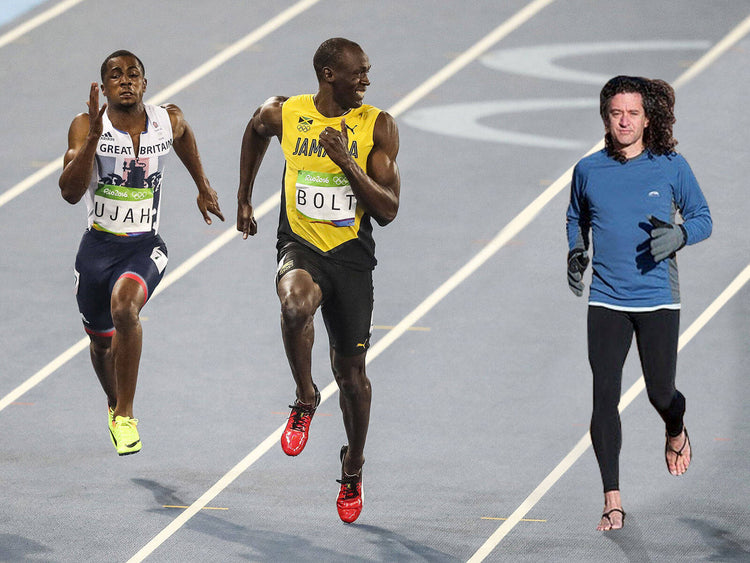
Usain Bolt beaten by 56 year old Xero Shoes CEO?!
We've seen Steven run from bears, lions, racecars, and more...but Usain Bolt?We've put this pic on Facebook, Instagram, Twitter and here, on the blog, where you can comment below. Head to one (or all) of those places and give us your best caption about Steven and the greatest sprinter of all time.One winner will be selected to receive a FREE pair of Xero Shoes of their choice. Winner will be selected April 25, 2019.
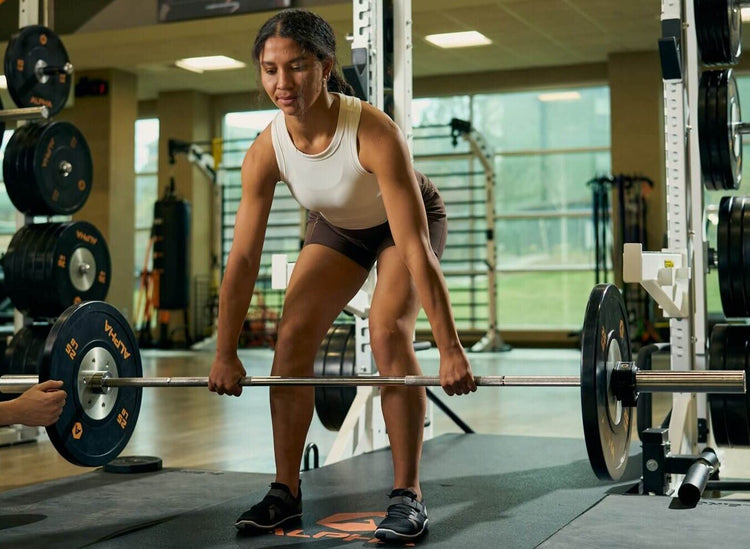
Barefoot Shoes for Weightlifting & Strength Training
By Allison GoldesteinThink about the last time you went to the gym to lift weights. You likely planned your outfit in advance. (How much will I be sweating? How good do I want to look? What’s actually clean?). But when was that last time you thought about the best shoes to wear for your workout?Unless you are a competitive weightlifter, you probably did not think much about your footwear. You just wore your sneakers, right? The shoes you wear to lift weights may also be the ones you wear to run, elliptical, play basketball, soccer, volleyball, or anything else.If those same shoes are your gym shoes, you’re compromising your strength workout and the gains you could get.Why Do Some Weightlifters Workout Barefoot?When you swing a kettlebell, snatch a barbell, or lift a dumbbell, it feels like you’re just using muscles to pull upward, against gravity. What most people forget, however, is that when you do these exercises, you’re also pushing down with your feet, into the earth.That downward force, which meets the ground at the soles of your feet, is the foundation of your exercise, so if you want to reap the most benefit from lifting weights—enlisting all the correct muscles and generating the most force to lift the heaviest weight that you can—that foundation has to be stable.For stability, you need three things: A wide base (have your toes spread) Sensation (i.e., you need to be able to feel the ground and how your feet interact with it) Muscular control and strength (which starts with your brain feeling that sensation Think about how difficult it is to walk on stilts, or even platform shoes (sorry ladies)—it’s hard because your feet are so far off the ground. You don’t get as much feedback from the proprioceptors—a fancy word for a type of neuron—in your soles, and you can’t enlist as many intrinsic foot muscles as you would if your feet were flat on the ground, especially if the sole is stiff.The same goes for wearing shoes with lots of cushioning: your foot is farther off the ground, which is less stable, you can’t feel the ground effectively, and the foam absorbs some (or much) of the force that you want to put directly into the ground.If you want the best experience of stability, feedback, and wide stance, and direct force application, you’ll want to try barefoot lifting—your feet can’t get any closer to the ground than that! However, most gyms won’t allow you to walk around barefoot, and you might not want to, given the risk of stepping on something sharp. Is It Better To Workout Barefoot Or In Shoes? Many people assume that wearing shoes is an absolute must when working out, but the truth is that exercising barefoot can also be effective. In fact, some professional lifters don’t even wear shoes during their workouts. So why do some lifters workout barefoot? Powerlifters say, “strength begins with the feet”, even for bench presses. Barefoot training can offer you: Better balance and stability. Shoes can create an unstable base for your lifts as the padding and elevated heel can shift your weight distribution. By lifting barefoot, your feet make direct contact with the ground, allowing your body to adjust accordingly. Improved proprioception. This refers to your body’s ability to sense and understand its position in space. When your feet make direct contact with the ground, your body can better make use of its sensory feedback. Better form. When lifting barefoot, your feet and toes can better grip the ground and maintain balance, which translates into better technique. Reduce pressure. Your feet have natural shock absorption in them. By weightlifting in bare feet, your body can better make use of this in order to reduce the pressure on your knees and ankles. Strengthen foot muscles. Lifting barefoot allows you to use the muscles in your feet and toes to actively stabilize your body. Over time, this will strengthen the muscles in your feet. If you want to experience these benefits, but don’t want to go completely barefoot (or your gym won’t let you), you can try lifting weights in barefoot shoes. These shoes allow you to get as close to being barefoot as possible while still having a layer of protection on your feet.Barefoot Shoes for WeightliftingWearing barefoot shoes with zero-drop for weightlifting is the closest experience to going barefoot that you can get. The term “zero drop” means that the shoe’s heel-to-toe drop is zero millimeters. Your heel is level with the rest of your foot, unlike the forward tilt you get in traditional running shoes that have elevated heelsAnother benefit of barefoot shoes for weightlifting is building foot strength. Strong feet give you a better base, something that can help with any lift where your feet are on the ground.Research shows that merely walking in minimalist shoes builds foot strength as much as doing a foot exercise program.The thin sole of Xero Shoes is designed with a zero-drop sole which allows your feet to be low to the ground. We have several barefoot shoes for weightlifting including Prio, Prio Neo, 360, Forza Trainer.The shoe’s wide toe box also lets your toes spread out, which adds stability, since it gives you a wider base. This is a lightweight shoe – when weightlifting, you’ll barely notice you have them on.Don’t just take our word for it. Here’s what some weightlifters have to say about their experience with barefoot shoes:Tips For Transitioning To Barefoot ExerciseWhether you are taking the plunge into going completely barefoot or switching to barefoot weightlifting shoes, here are some tips to get you started: If you’ve never worn minimalist shoes before, you’ll want to introduce them the way you would any new exercise or gear—slowly. Practice foot strength exercises. Those little muscles in your feet that are used to slacking off will need time to acclimate and strengthen. A 2019 study by Dr. Sarah Ridge found that walking in minimalist shoes strengthens the muscles in your feet as much as following a foot strengthening exercise program. As your feet and muscles get stronger, slowly increase the duration and intensity of your workouts. Add new exercises and movements slowly to avoid overexertion. Listen to your body and rest when needed. Don't push yourself too hard too quickly or ignore any discomfort. When you start heavy lifting with barefoot shoes, try using a removable insole so you can decide just how close to the ground you want to be. Be patient on your barefoot training journey. Being patient can be difficult, but your body will thank you. In the long run, making the switch in your weightlifting routine will pay off. The content of this post does not constitute and is not intended to be a substitute for professional medical advice, diagnosis or treatment. Always seek the advice of a physician or other qualified health provider with any questions or concerns you may have about your health or a medical condition.Barefoot Shoes for LiftingXero Shoes has several models for barefoot weightlifting. Try the Prio, Prio Neo, 360, Forza Trainer model for weightlifting or strength training - available in many sizes and colors.



